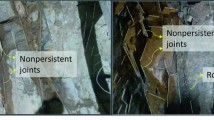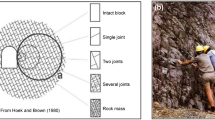Abstract
Large deformation of anchored rock masses or pull-out failure of anchor bolts often occurs in tunneling practices. The existence of incipient joints in rock masses might account for the failure of anchor bolts. The strength of the anchored rock mass varied with the geometric property of the joints and might be less than the target value. A series of numerical modeling experiments have been carried out in the present study by utilizing the FLAC3D software package. A novel method has been proposed to establish and validate numerical models such that they can simulate and extend physical experimental results. Accordingly, we demonstrated that the application of anchor bolts increases the strength of the jointed rock blocks but significantly depends on the orientation of incipient joints. The anchor bolt reduces the nonuniformity of the stress distribution, and the uniformity increases gradually with increasing bolt density. Moreover, the application of anchor bolts would keep the rock blocks as intact to contain the tendentious failure along the incipient joint planes. The findings in the present study would benefit the stabilization of rock masses adjacent to an underground tunnel, especially at the initial stage of failure when only incipient joints exist.



















Similar content being viewed by others
Data Availability
Enquiries about data availability should be directed to the authors.
References
Cao RH, Cao P, Lin H, Ma GW, Zhang CY, Jiang C (2018) Failure characteristics of jointed rock-like material containing multi-joints under a compressive-shear test: experimental and numerical analyses. Int J Archiv Civ Mech Eng 18(3):784–798
Cao RH, Lin H, Lin Q, Meng J (2020) Failure mechanism of non-persistent jointed rock-like specimens under uniaxial loading: laboratory testing. Int J Rock Mech Min Sci 132:104341
Grasselli G (2005) 3D Behaviour of bolted rock joints: experimental and numerical study. Int J Rock Mech Min Sci 42:13–24
Haas CJ (1981) Analysis of rock bolting to prevent shear movement in fractured ground. Int J Rock Mech Min Sci 33:698–704
Han GS, Jing HW, Jiang YJ et al (2018) The effect of joint dip angle on the mechanical behavior of infilled jointed rock masses under uniaxial and biaxial compressions. Processes 6(5):49
Hencher RS (2014) Characterizing discontinuities in naturally fractured outcrop analogues and rock core: the need to consider fracture development over geological time. Geol Soc Lond Spec Publ 374(1):113–123
Indraratna B, Aziz NI, Dey A (2001) Behaviour of joints containing clay infill under constant normal stiffness, with and without bolting. Geotechn Eng 149(4):259–267
Jing HW, Yang SQ, Zhang ML et al (2014) An experimental study on anchorage strength and deformation behavior of large-scale jointed rock mass. Tunn Undergr Space Tech 43:184–197
Lajtai EZ, Carter BJ, Duncan E (1994) En echelon crack-arrays in potash salt rock. Rock Mech Rock Eng 27(2):89–111
Li SC, Wang G, Wang SG et al (2006) Application of fracture-damage model to anchorage of discontinuous jointed rock mass of excavation and supporting. Chin J Rock Mech Eng 25(8):1582–1590
Li SJ, Feng XT, Li Z et al (2012) In situ monitoring of rock burst nucleation and evolution in the deeply buried tunnels of Jinping II hydropower station. Eng Geol 137–138:85–96
Meng B, Jing HW, Yang XX, Chen KF, Yang SQ (2013) Experimental study of deformation and failure characteristics of anchorage unit in fractured surrounding rocks. Chin J Rock Mech Eng 32(12):2497–2505
Pellet F, Egger P (1996) Analytical model for the mechanical behavior of bolted rock joints subjected to shearing. Rock Mech Rock Eng 29:73–97
Sun PP, Yang XX, Sun DK, Qiao WG, Wu Y (2019) Geometric and mechanical properties of a shear-formed fracture occurring in a rock bridge between discontinuous joints. Bull Eng Geol Environm 79:1365–1380
Wang G, Zhang YZ, Jiang YJ et al (2018) Shear behaviour and acoustic emission characteristics of bolted rock joints with different roughnesses. Rock Mech Rock Eng 51:1885–1906
Wong RHC, Chau KT (1998) Crack coalescence in a rock-like material containing two cracks. Int J Rock Mech Min Sci 35:147–164
Wong RHC, Chau KT, Tang CA, Lin P (2001) Analysis of crack coalescence in rock-like materials containing three flaws-part I: experimental approach. Int J Rock Mech Min Sci 38:909–924
Wu XZ, Jiang YJ, Li B (2017) Influence of joint roughness on the shear behaviour of fully encapsulated rock bolt. Rock Mech Rock Eng 51:953–959
Yang XX, Kulatilake P (2019) Laboratory investigation of mechanical behavior of granite samples containing discontinuous joints through direct shear tests. Arab J Geosci 12(2):79
Yang XX, Qiao WG (2018) Numerical investigation of the shear behavior of granite materials containing discontinuous joints by utilizing the flat-joint model. Comput Geotech 104:69–80
Yang XX, Kulatilake P, Jing HW, Yang SQ (2015) Numerical simulation of a jointed rock block mechanical behavior adjacent to an underground excavation and comparison with physical model test results. Tunn Undergr Space Techn 50:129–142
Yang XX, Jing HW, Tang CA, Yang SQ (2017) Effect of parallel joint interaction on mechanical behavior of jointed rock mass models. Int J Rock Mech Min Sci 92:40–53
Zhang ML (2013) Research on crack evolution and bolting mechanism of intermittently jointed rocks. China University of Mining and Technology, Xuzhou
Acknowledgements
This research was supported by the National Natural Science Foundation of China (Grant Nos. 51734009 and 51704183) and Postdoctoral Science Foundation of China (Grant No. 2018M640646).
Funding
The authors have not disclosed any funding.
Author information
Authors and Affiliations
Corresponding author
Ethics declarations
Conflict of Interest
The authors declare no conflict of interest.
Additional information
Publisher's Note
Springer Nature remains neutral with regard to jurisdictional claims in published maps and institutional affiliations.
Rights and permissions
Springer Nature or its licensor holds exclusive rights to this article under a publishing agreement with the author(s) or other rightsholder(s); author self-archiving of the accepted manuscript version of this article is solely governed by the terms of such publishing agreement and applicable law.
About this article
Cite this article
Jing, HW., Yang, XX. & Zhang, ML. Strength and Failure Behaviors of a Jointed Rock Mass Anchored by Steel Bolts: A Numerical Modeling Study. Geotech Geol Eng 41, 225–241 (2023). https://doi.org/10.1007/s10706-022-02275-7
Received:
Accepted:
Published:
Issue Date:
DOI: https://doi.org/10.1007/s10706-022-02275-7




